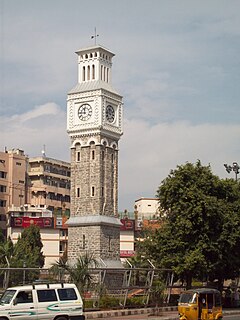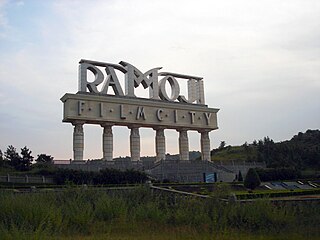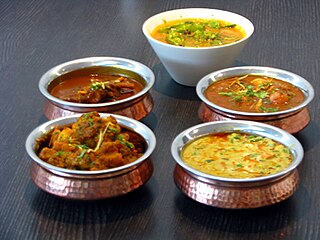
Hyderabad is the capital of the Indian state of Telangana and de jure capital of Andhra Pradesh. Occupying 650 square kilometres (250 sq mi) along the banks of the Musi River, Hyderabad City has a population of about 6.9 million and about 9.7 million in Hyderabad Metropolitan Region, making it the fourth most populous city and sixth most populous urban agglomeration in India. At an average altitude of 542 metres (1,778 ft), much of Hyderabad is situated on hilly terrain around artificial lakes, including Hussain Sagar—predating the city's founding—north of the city centre.

Telangana is a state in India situated on the centre-south stretch of the Indian peninsula on the high Deccan Plateau. It is the twelfth largest state and the twelfth-most populated state in India with a geographical area of 112,077 km2 (43,273 sq mi) and 35,193,978 residents as per 2011 census. On 2 June 2014, the area was separated from the northwestern part of Andhra Pradesh as the newly formed 29th state with Hyderabad as its historic permanent capital. Its other major cities include Warangal, Nizamabad, Khammam and Karimnagar. Telangana is bordered by the states of Maharashtra to the north, Chhattisgarh to the east, Karnataka to the west, and Andhra Pradesh to the east and south. The terrain of Telangana region consists mostly of hills, mountain ranges, and thick dense forests distribution of 27,292 sq. km. As of 2019, the state of Telangana is divided into 33 districts.

Secunderabad is the twin city of Hyderabad located in the Indian state of Telangana. Named after Sikandar Jah, the third Nizam of the Asaf Jahi dynasty, Secunderabad was established in 1806 as a British cantonment. Although both the cities are together referred to as the twin cities, Hyderabad and Secunderabad have different histories and cultures, with Secunderabad having developed directly under British rule until 1948, and Hyderabad as the capital of the Nizams' princely state of Hyderabad.

Haleem is a stew popular in the Middle East, Central Asia, and the Indian subcontinent. Although the dish varies from region to region, it always includes wheat or barley, and sometimes meat and/or lentils. Popular variations include keşkek in Turkey, Iran, Afghanistan, Tajikistan, Uzbekistan, Azerbaijan and northern Iraq; Hareesa in the Arab world and Armenia; Halim in Bangladesh and West Bengal, India; Khichra in Pakistan and India. Americans also have a similar dish called Farina.
The Chaush are Muslim community of Hadhrami Arab descent found in the Deccan region of India. The name is believed to originate from the Turkish word Chiaus used during the Ottoman era of the Balkans for military officers who were often tasked with guarding palaces. They have a common origin with the Chavuse community of Gujarat.

Hyderabadi biryani is a variety of biryani from Hyderabad, India. It is prepared from rice using the dum method of cooking.

The Ramoji Film City in India is located in Hyderabad. Spread over 2000 acres, it is the largest integrated film city in Telangana and has been certified by the Guinness World Records as the largest studio complex in the world. It was built by Telugu film producer Ramoji Rao in 1996.

Hyderabadi Muslims are an ethnoreligious community of Dakhini Urdu-speaking Muslims, part of a larger group of Dakhini Muslims, from the area that used to be the princely state of Hyderabad, India, including cities like Hyderabad, Aurangabad, Latur, Gulbarga and Bidar.
Hyderabad Colony is a neighborhood of Gulshan Town, Karachi, Sindh, Pakistan. Hyderabad Colony was originally inhabited by Hyderabadi Muslim migrants from Hyderabad Deccan. It is famous for its popular Hyderabadi food, including Hyderabadi biryani, chaakna, Hyderabad Haleem and especially achar (pickle). Abu Mian, a catering service popular among the Hyderabadis of Karachi, is located in Hyderabad Colony. The first Mosque in the neighbourhood was the Makkah Masjid which was the center of the social and religious activity in the vicinity. Muhammad Multani Qadri was the first president of the Makkah Mosque Foundation and was a well-known and respectable elder in the colony. Currently, the colony is fast changing its actual look and surroundings. With recently constructed flyover near Central Jail and speedy construction of flats, the area is now completely different from the one that used to be in early 1980s. Few of the old shops still exist but most of the old ones are either transformed or closed.Nasar Ullah Khan Shajee was also born at Hyderabad colony and elected Member of Sind Assembly .Prominent politician and Naib Ameer of a politico-religious party Jamaat-e-Islami (JI), Nasrullah Shaji, drowned in river while saving live of a school student during a tour in Balakot. Former Pakistani lawmaker in Sindh assembly and renowned leader cum educator, Nasrullah Shaji, drowned into River Kunhar as he jumped to save life of his matriculation boy fell into water during the study tour in Balakot

Khichdi, or khichri, is a dish from the Indian subcontinent made from rice and lentils (dal), but other variations include bajra and mung dal kichri. In Indian culture, it is considered one of the first solid foods that babies eat. Hindus, who avoid eating grains during fasting, eat Sabudana Khichadi made from sago. Kichri is a salty porridge. Dalia is another similar sweet porridge made from the crushed wheat or barley mixed with sugar and milk. It was the inspiration for the Anglo-Indian dish kedgeree.

Mirza Ghassemi is an Iranian appetizer or main based on tandoori or grilled aubergine (eggplant), distinct to the Northern Iran and Caspian Sea region and specially gilan province. It is widely known as Persian Eggplant Dip in the Western countries.

MediCiti Institute of Medical Sciences is an Indian medical college affiliated with Dr. NTR University of Health Sciences.

Hyderabadi cuisine, also known as Deccani cuisine, is the native cooking style of the Hyderabadi Muslims, and began to develop after the foundation of the Bahmani Sultanate, and more drastically with the Qutb Shahi dynasty around the city of Hyderabad, promoting the native cuisine along with their own. Hyderabadi cuisine had become a princely legacy of the Nizams of Hyderabad State, as it began to further develop further on from there. It is an amalgamation of Mughal, Turkish, and Arabic along with the influence of the native Telugu and Marathwada cuisines. Hyderabadi cuisine comprises a broad repertoire of rice, wheat and meat dishes and the skilled use of various spices, herbs and natural edibles.

Bagara khana or Bagara annam is a spiced rice delicacy prepared in Hyderabad, Telangana, India. Bagar, meaning tempering, is a plain Biryani recipe without any vegetables or masala powders.

Santosh Nagar, or Santoshnagar, is a residential and commercial area in Hyderabad, India. It is located near Saidabad in the Old City of Hyderabad and DRDO laboratories. Hyderabad International Airport is about 14 kilometres (8.7 mi) from here, spanning a 30 minute drive. It is divided into two areas—the Old Santoshnagar Colony and The New Santoshnagar Colony. Santoshnagar falls under the Yakutpura assembly constituency, which is represented by All India Majlis-e-Ittehadul Muslimeen Legislator Mumtaz Ahmed Khan.

Many cuisines feature eggplant salads and appetizers.
Husri is a town and union council of Hyderabad District in the Sindh province of Pakistan. It is part of the rural Taluka of Hyderabad and is located at 25°19'0N 68°25'0E and lies to the south-east of the capital Hyderabad. Husri plays an important role in Hyderabad's and Sindh's politics. A recent study concluded that this town is known to be over 100 years old. This micro city has a widespread abundance of garments, toys etc. Various politicians from Sindh visit this diversified town. It is widely known for its politics. Most of the town supports PPP. There have been a few Riots in this town due to people over supporting a certain party that leads in tremendous problems.
Madannapet is a suburb of Hyderabad, India.

Baingan bharta is a dish from the Indian subcontinent that originated in the Punjab region. 'Baingan ka bharta' is a part of the national cuisines of all nation states of the Indian subcontinent. It is a vegetarian dish that is prepared by mincing eggplant (baingan) that is grilled over charcoal or direct fire. This infuses the dish with a smoky flavour. The smoked and mashed eggplant is then mixed with cooked chopped tomato, browned onion, ginger, garlic, cumin, fresh cilantro, chili pepper, and mustard oil or a neutral vegetable oil. Traditionally, the dish is often eaten with an Indian flatbread and is also served with rice or raita, a yogurt salad. In states such as Bihar and Uttar Pradesh, it is served hot with litti.





















